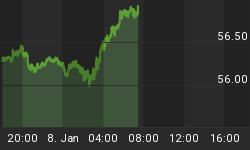A viable "V" shaped recovery in the economy and markets has now become the accepted view. My view, however, is that the economic recovery will be ephemeral in nature, whereas the real and lasting recovery will be unfortunately found in the rate of inflation. While nearly everyone on Wall Street remains unconcerned about inflation, the cornerstone for increasing prices has already been laid and the foundation is nearing completion.
The zero percent interest rates, which have already been in effect for too long, will have a similar effect -- think housing and credit bubble--that a 1% Fed Funds rate did in from June 2003 thru June 2004. Just for the record, the target rate for Fed Funds has been one percent or less since October of 2008. In case you are wondering what bubble the Fed is busy blowing this time around you don't have to look any further than the U.S. bond market.
A hat tip must go to Keith McCullough CEO of Hedgeye Risk Management for realizing that inflation has made a salient comeback, much like the economy has. While the S&P has inflated up 80% from the March 2009 low, inflation indicators across the board have also gone into overdrive.
Last week's release of the Producer Price Index should have sent shivers through the spines of those who worry about silly things like profit margins. Prices for finished goods shot up .7% month over month, while surging 6% YOY. Intermediate goods surged 7.7% YOY. Crude goods soared 3.2% since March and jumped 33.4% YOY! If that's not a "V" shaped recovery in inflation what would you call it?
Thanks to the now record-high Fed's balance sheet ($2.32 trillion), which jumped $20 billion since just last week, inflation data has become quite predictably disturbing. The Consumer Price Index is up 2.4% YOY. Intractable inflation that is not, but it's still a far cry from the 2% drop in CPI of last summer and in no way can be considered deflationary. Import prices are up 11.4% YOY and increased .7% in April from the prior month. More evidence of the "V" shaped recovery in inflation can be found in the prices paid component in the ISM Index, which jumped 8 percentage points in March to 75 from 67.
But none of this matters to counterfeiter in Chief Ben Bernanke. So while unemployment remains stubbornly high, consumers must also deal with the erosion of their purchasing power.
The national debt is approaching $13 trillion and even President Obama predicts the debt as a percentage of GDP will be over 100% in 2015. Meanwhile, annual deficits are already 10% of GDP even though interest rates are in the basement.
So perhaps this resurgent inflation is all part of a concerted effort between the Fed and the Treasury to inflate away our massively building debt obligation. More and more you hear about the inflation "solution" to our debt. But this new solution coming from Wall Street and Washington geniuses is the same solution that has been deployed throughout history; when you can't cut spending, grow the economy or tax your way to fiscal responsibility, you print your way there.
Their belief goes something like this; you create a surge in inflation for a brief period of time and thus lower the nation's debt in real terms. That inflation will also increase the asset prices of Americans and boost exports as the dollar weakens. You see, the economy booms and the government is also bailed out from its debt burden. Yippee!!!
That's what the head of Weimar Germany's Reichsbank Rudolf von Havenstein thought before he "briefly" sent inflation up to over 16 million percent and unemployment reached nearly 50%--take that all of you Phillips Curve followers who contend that inflation can't exist when there is slack in the labor market.
Of course nothing nearly that dramatic is predicted to occur here in the United States but the point is that the desire to seek inflation as a panacea has already been tried many times throughout history and it has a zero percent success rate.
According to some on Wall Street another part of the plan is to force banks to buy Treasuries. Here is an excerpt from "Why Inflation Would Be Good for Us", which can be found at MSN Money: Another option to keep borrowing costs down would be to force banks to purchase more Treasury debt via regulatory requirements. With the Fed keeping short-term interest rates near zero, the banks would be happy to play along, because they would collect the difference between 0.15% on overnight loans and 4% on 10-year Treasury notes. The banks would get easy profits, the politicians wouldn't have to make uncomfortable fiscal reforms, the government could keep interest payments low, and the Fed could pump inflation into the system. Everyone would win!
You see that, it's brilliant. Printing money bails out banks while sending prices up for all consumers. The public gets screwed by earning nothing on their savings but paying more for everything they need to survive. Their purchasing power plunges and they can only afford to buy the basic necessities. Real wages drop sharply and unemployment surges. But who cares? Bank profits will be great!
Sorry, not everyone wins with inflation. Only the very rich come out unscathed. But Mr. Bernanke believes an emergency Fed Funds rate still needs to be in place and that the balance sheet of the Federal Reserve does not need to shrink in short order. Given his preference to manage inflation higher, investors should manage their portfolios appropriately.
















